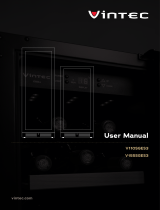
13
INSTALLATION
• Use the wine cellar only to store wines and
do not put any other type of food into it.
• The appliance must be handled and installed
by two or more persons.
• Be careful not to damage the floors (e.g.
parquet) when moving the appliance.
• During installation, make sure the appliance
does not damage the power cable.
• Make sure the appliance is not near a heat
source.
• To guarantee adequate ventilation,
leave a space on both sides and above
the appliance and follow the installation
instructions.
• Keep the appliance ventilation openings
free.
• Do not damage the appliance refrigerant
circuit pipes.
• Install and level the appliance on a floor
strong enough to take its weight and in a
place suitable for its size and use.
• Install the appliance in a dry and well-
ventilated place.
The appliance is arranged for operation
in places where the temperature comes
within the following ranges, according to the
climatic class given on the rating plate. The
appliance may not work properly if it is left
for a long time at a temperature outside the
specified range.
• Make sure the voltage specified on the rating
plate corresponds to that of your home.
• Do not use single/multi adapters or
extension cords.
• For the water connection, use the pipe
supplied with the new appliance; do not
reuse that of the previous appliance.
• Power cable modification or replacement
must only be carried out by qualified
personnel or by After-sales Service.
• It must be possible to disconnect the
appliance from the power supply by
unplugging it or by means of a mains two-
pole switch installed upstream of the socket.
SAFETY
• Do not store explosive substances such as
aerosol cans with a flammable propellant in
this appliance.
• Do not store or use petrol, flammable liquids
or gas in the vicinity of this or other electrical
appliances. The fumes can cause fires or
explosions.
• Do not use mechanical, electric or chemical
means other than those recommended by
the Manufacturer to speed up the defrost
process.
• Do not use or place electrical devices inside
the appliance compartments if they are
not of the type expressly authorised by the
Manufacturer.
• This appliance is not intended for use by
persons (including children) with reduced
physical, sensory or mental capabilities,
or lack of experience and knowledge,
unless they have been given supervision or
instruction concerning use of the appliance
by a person responsible for their safety.
• To avoid the risk of children becoming
trapped and suffocating, do not allow them
to play or hide inside the appliance.
USE
• Before carrying out any maintenance or
cleaning operation, unplug the appliance or
disconnect it from the power supply.
• “The bulb used inside the appliance
is specifically designed for domestic
appliances and is not suitable for
general room lighting within the home
(EC Regulation 244/2009)”.
The Manufacturer declines any liability if
the above advice and precautions are not
respected.
Important:
• If large amounts of wine are put in the
appliance, it may take several days for it to
reach a constant temperature.
• Caution! The storage temperature must
never drop below +6°C.
• When the appliance is working, drops of dew
or frost may form on the inner liner wall. This
depends on the operation. There is no need
to scrape the frost off or dry off the dew. The
back wall defrosts automatically. The defrost
water is automatically conveyed to a drain
hole, and then collected in a container where
it evaporates.
• The bottles can be stored neatly on the
wooden racks. Each shelf can bear a
maximum weight of 40 Kg.
GENERAL PRECAUTIONS AND
SUGGESTIONS
Climatic Class Amb. T. (°C) Amb. T. (°F)
SN from 10 to 32 from 50 to 90
N from 16 to 32 from 61 to 90
ST from 16 to 38 from 61 to 100
T from 16 to 43 from 61 to 110










